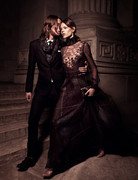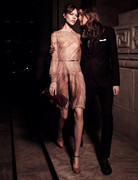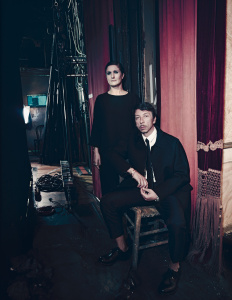I noticed in every Valentino thread nowadays there's always be a love/hate relationship with these two. I'll open up the discussion with this Interview article.
Interview May 2011
Valentino: State of Grace
By Giancarlo Giammetti
Photography Mikael Jansson




Interview May 2011
Valentino: State of Grace
By Giancarlo Giammetti
Photography Mikael Jansson




interviewmagazineSince taking the reins two and a half years ago as creative directors at Valentino,designers Maria Grazia Chiuri and Pier Paolo Piccioli have faced numerous challenges—not the least of which has involved building upon the enormous legacy of the legendary Valentino Garavani, who retired from the house that bears his name in January 2008. Mr. Valentino may have left his business, but he didn’t retreat from the fashion world and certainly not from his very active social life. Today Valentino’s image continues to loom large, both figuratively and literally, over the fashion empire that he and his longtime business partner, Giancarlo Giammetti, built together over the span of nearly five decades.
Chiuri and Piccioli, who had previously served as accessories designers under Valentino for more than a decade, were appointed in 2008 following the brief run of Alessandra Facchinetti, who took over after Valentino’s retirement and promptly moved to etch out a new, very different image for the Valentino woman, but lasted just two seasons at the helm. In stepping in after Facchinetti’s departure, Chiuri and Piccioli were thrust into the position of having to determine the future of a brand at across roads. The journey has not been without some bumps along the way: a debut collection that some deemed too reverently old-school Valentino; another, an Avatar-inspired collection that others deemed not Valentino enough; and their ongoing struggle to carve out their own path as a design team—and working to reconcile that vision with the history of Valentino—in a very public way.
Recently, though, Chiuri and Piccioli have started to hit their stride. Their Fall 2011 collection, presented this past March in Paris, offered clear evidence of why they’ve quietly captured the hearts of Young Hollywood’s hippest girls (among them, this month’s cover girl, Michelle Williams, who wore Valentino to the Golden Globes), while creating a new language of grace and fragility in fashion—one that contains a delicate balance of romantic prettiness and edginess that has gently seduced women back into kitten heels, longer lengths, sheer layers, lace, ruffles, and bows—and a lightness of being that is quickly becoming the signature for the Valentino girl of the future.
The day after the show, Chiuri and Piccioli visited Giammetti at Valentino’s castle, Chateau de Wideville, in Davron, a half hour outside of Paris, to discuss the burdens of stepping into the shoes of their former boss, the Last Emperor, and how they think they’ve found a way to the future by looking into the past. Since taking the reins two and a half years ago as creative directors at Valentino, designers Maria Grazia Chiuri and Pier Paolo Piccioli have faced numerous challenges—not the least of which has involved building upon the enormous legacy of the legendary Valentino Garavani, who retired from the house that bears his name in January 2008. Mr. Valentino may have left his business, but he didn’t retreat from the fashion world and certainly not from his very active social life. Today Valentino’s image continues to loom large, both figuratively and literally, over the fashion empire that he and his longtime business partner, Giancarlo Giammetti, built together over the span of nearly five decades.
Chiuri and Piccioli, who had previously served as accessories designers under Valentino for more than a decade, were appointed in 2008 following the brief run of Alessandra Facchinetti, who took over after Valentino’s retirement and promptly moved to etch out a new, very different image for the Valentino woman, but lasted just two seasons at the helm. In stepping in after Facchinetti’s departure, Chiuri and Piccioli were thrust into the position of having to determine the future of a brand at a crossroads. The journey has not been without some bumps along the way: a debut collection that some deemed too reverently old-school Valentino; another, an Avatar-inspired collection that others deemed not Valentino enough; and their ongoing struggle to carve out their own path as a design team—and working to reconcile that vision with the history of Valentino—in a very public way.













